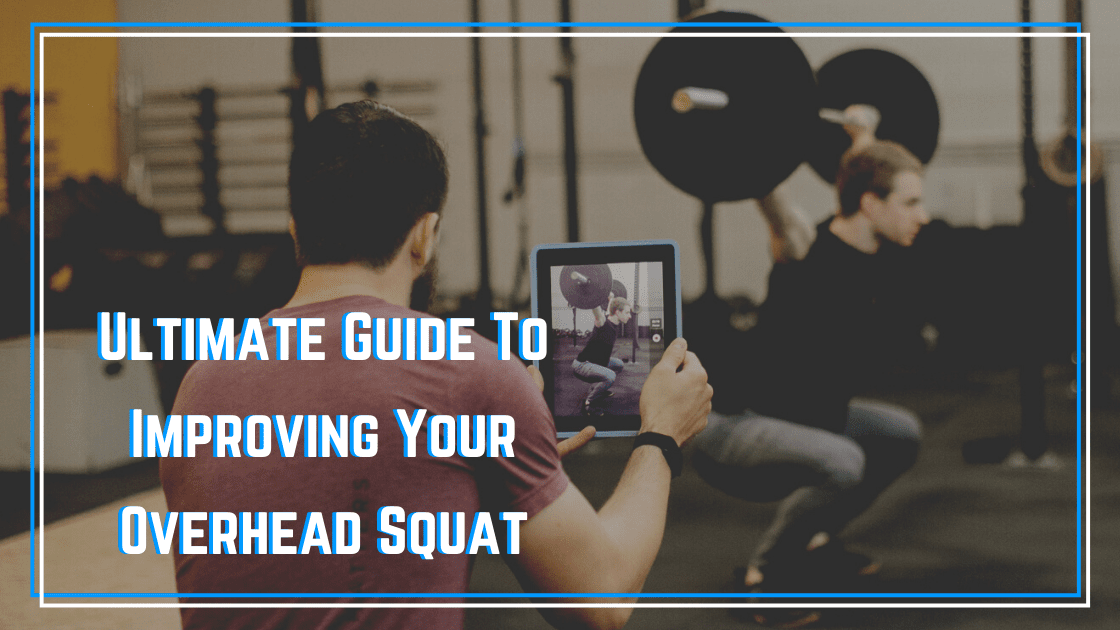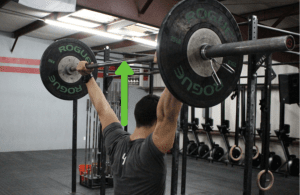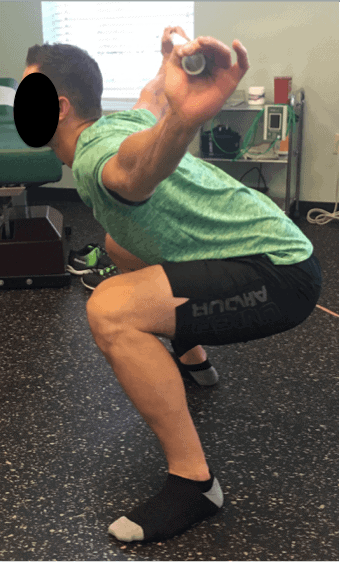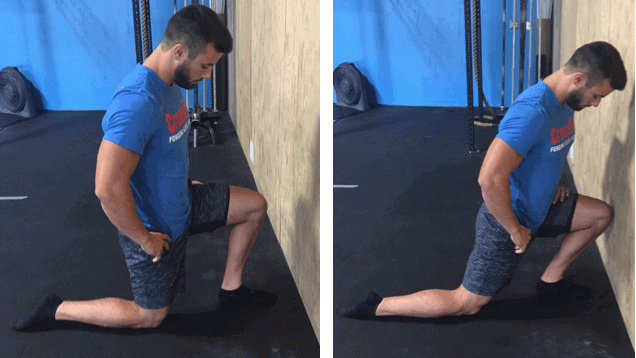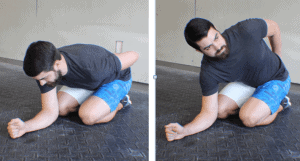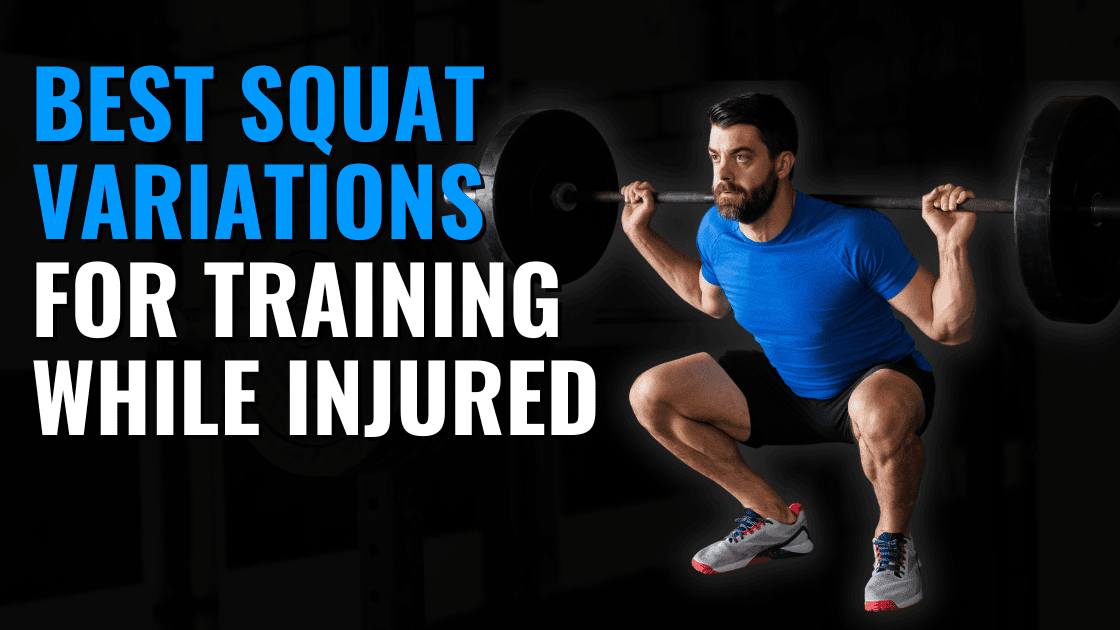You walk into your gym and on the white board there it is…the overhead squat. While a few athletes will be thrilled to see this movement most of us won’t. The combination of mobility, strength, control, and coordination needed for this exercise makes it one of the most difficult for many CrossFit athletes.
But there is hope. With the assessments and mobility drills outlined below you can form a gameplan to turn the overhead squat into one of your favorite exercises instead of one you dread!
For more help improving your mobility, access our FREE mobility checklist!
.
Improving Your Overhead Squat Mobility
By placing the weight over your head in this squat variation we’ve significantly increased the stability demands of the overhead squat. When your positioning gets even slightly off track, the exercise becomes drastically more difficult to perform. So optimizing our positioning is step one.
Our best positioning happens when we can stack multiple joints on top of each other and use a combination of muscle strength and boney alignment to maximize barbell stability. To do this we want the barbell, shoulder joint, hips, and ankles stacked as close on top of each other as possible.
To achieve this stacked position, we’ll want to keep an upright torso, which can only be achieved if we push the knees over the toes during the squat. When ankle mobility is limited, it makes it impossible to achieve this position as shown below. The torso will then drop forward, placing the shoulder in position of hyperabduction. This puts lots of stress on the anterior shoulder structures and makes stabilizing heavy loads overhead difficult.
The following video of a PVC pipe OHS demonstrates this point where the squat in front of a box simulates someone with stiff ankles performing this movement.
View this post on Instagram
.
Grip Width in the Overhead Squat
Your grip width is an important consideration with the overhead squat. I typically start with the below test as it positions our grip at a position that readily translates into the best grip width for snatching. This test will place the barbell where it won’t smash the pubic bone in the snatch but is also wide enough to allow for proper shoulder motion.
From here, we can adjust our grip width based on individual needs and comfort. For those with excellent shoulder mobility, a narrower grip width may add a little stability in their overhead position. For those with reduced mobility, widening can allow for more ease of movement. Ultimately, the above test is a solid starting point where most athletes will be comfortable.
.
Shoulder Positioning in the Overhead Squat
Much has been said and debated in terms of shoulder positioning during the OHS. For example, Chinese weightlifters are often taught to fully internally rotate their shoulders when overhead. American lifters are often cued to do the opposite and externally rotate the shoulder. Other coaches and athletes focus on cueing the shoulder blade into different positions.
I think we make this too complicated. I cue two things. First, maintain an active shoulder where you are pressing vertically up into the bar rather than allowing it to push your shoulders down.
Second, I cue to keep the shoulder in a more neutral position where the point of the elbow faces out to the sides. This combo is a strong position for holding the weight over your head with an active rotator cuff to stabilize the shoulder.
This is a simple explanation of the positioning I cue for those wanting a more in-depth analysis of the above points Catalyst Athletics dives deeper into the subject. In this article, Greg breaks down how most athletes position their shoulders the same, even though the cues used are different. Note they do cue the shoulder blade to retraction & upwardly rotate. I just believe the cue to actively push upward into the bar accomplishes this with more straightforward terms for the average gym-goer.
Ankle Mobility
As mentioned earlier, ankle mobility is a huge component of getting into optimal positioning for the overhead squat. When limited, the torso is forced forward and the shoulders are placed in a weak position for efficient transfer of force from the legs to the barbell overhead (pic below). We’ll also see lots of knees collapsing in the overhead squat when ankle mobility is lacking.
To test ankle mobility, I usually start with the following test. The athlete is in the bottom of a lunge with his or her big toe on hand width away from a wall. We then see if they can keep their heel flat on the ground while pushing knee forward and touching the wall. If an athlete cannot do this, ankle mobility may need to be addressed.
I’ve shared several ankle mobility drills in this article and our Ankle Mobility Overhaul program. It is also important to note that many athletes have decent mobility but don’t use it when they overhead squat. In that case, the following drill is one of my favorites. The band helps pull the athlete’s knees forward so that they can get more comfortable in this position.
.
Stance Width
Next up, we need to determine an athlete’s best stance width for the overhead squat. The hip scour test described in this video is my go-to to feel where the most available hip mobility is for that athlete. After running this test, we stand up and squat at that hip-width. Then play around with different levels of toe-in and out to find the most comfortable position that also optimizes our squat depth.
For many failing the ankle mobility test, we may deviate a bit here. Often a wider stance and/or a more toe-out stance in the squat can commonly be used to compensate for stiffness in the ankles.
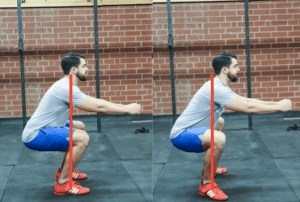
Notice how turning the toes further out (right) brings the hips closer to the middle of the foot.
.
Thoracic Mobility
Moving further up the kinetic chain, we also have to address upper back mobility. When the thoracic spine is stiff, the shoulders have to do extra work to hold weight overhead. In the overhead squat, they’ll already be tested to their maximum, so we don’t have much room for compensation.
To test your thoracic mobility, we’ll do the following assessment. For different exercises to address thoracic spine mobility, see this article and this program.
To test thoracic spine rotation/extension mobility, begin sitting on knees with your butt on your heels. Place one forearm on the ground and the other behind your back. Rotate towards the up hand. Fifty degrees of rotation should be available in each direction (shoulders relative to the ground).
.
Shoulder Mobility
To test shoulder mobility for the overhead squat, we’ll grab a pvc pipe with a shoulder-width grip and palms down. Sit with legs crossed and your back flush to the wall. While keeping elbows straight, see if you can touch your forearms to the wall. For extra credit, reverse your grip and repeat.
Fall short of this marker? You can check out our Performance Plus Overhead Mobility plan.
.
What If It’s Not Your Mobility?
Many athletes with good mobility still struggle with the coordination of the overhead squat with how many different joints are involved in this exercise. For them, a few exercises shown below are great to build a baseline level of control on which we can then start strengthening on top of.
Overhead Sit Squats look much easier than they are. Position a ball or box at the lowest level at which you can overhead squat comfortably just in front of a rig. The rig will force you to keep an upright torso with shoulders fully opened up. Next, get set up in your squat stance and lift off the box one inch before sitting back down. When you sit, only place about 50% of your weight on the box so that you never fully relax.
Repeat this small upwards lift repeatedly to build comfort in the bottom of the overhead squat. If set up correctly, 20-30 seconds of this motion should have your legs on fire. As you progress, perform off a lower surface.
View this post on Instagram
Overhead Squat Exaggeration drills, progressively lower sotts press’, and the goblet squat & press make three other exercises that I’ll regularly program to clean up overhead squat form.
View this post on Instagram
.
Want more?
We’ve got a variety of programs and products to help you improve your overhead squat.
For athletes, check out our Overhead Squat Overhaul and over twenty other programs inside of Performance Plus that will help you improve strength, mobility, and coordination for any fitness goal!

